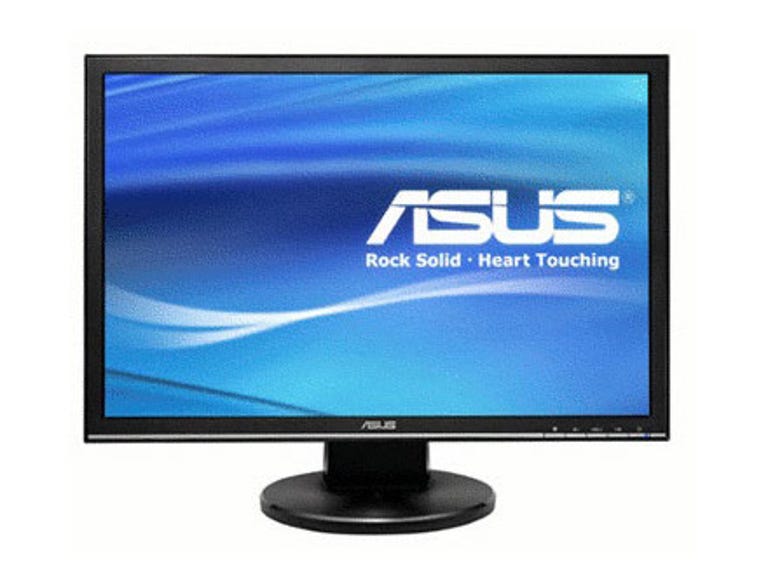 Why You Can Trust CNET
Why You Can Trust CNET Asus VW223B review: Asus VW223B
The Asus VW223B is acceptable for its intended audience — those who need to add a second monitor cheaply, and are undemanding in its use.
We need to establish something first — Asus' 22-inch VW223B is not a primary monitor. You really shouldn't buy this if you're looking for your one and only screen. The reason for this, is that the VW223B hooks up over USB, using a technology called DisplayLink.
The Good
The Bad
The Bottom Line
This introduces a few limitations: the first of which is that it needs a driver to work. Asus supplies one, although curiously on an 8cm disc instead of the usual 12cm, which immediately eliminates all slot-load optical drives from using it. Fortunately the drivers are also available on Asus' website.
It's also Windows only, eliminating all Mac and Linux users — although DisplayLink themselves offer an OS X beta driver here. It looks like it's basic VESA support only, as 2D and 3D acceleration are not supported.
Since it requires a driver to work, the VW223B will not turn on until Windows has loaded, handily rendering it useless for BIOS tweaking, and initially loads in mirrored mode until you log in, only then switching to extended mode if you've previously set it as such. Thankfully it also hooks up over VGA should you require greater compatibility, but there is no DVI here. This makes the VW223B an interesting beast, targeted at an interesting market — we'd imagine mostly businesses, where the employee in question already has a monitor hooked up, but needs a cheap way of adding a second one for something less taxing like spreadsheets.
Asus supplied us with two monitors, and upon opening the box we noticed each featured a three port USB hub on the left — and so we immediately set about daisy chaining one from the other to see if it would work. It did.
At this point we turned to performance. As any FireWire fan will tell you, although USB 2.0 has an upper bandwidth limit of 480Mbps, that's certainly not the sustained rate, so we started with a few tests.
Windows XP performance at 1,680x1,050 was fine, with no discernible problem — a good start. Then we broke out the video.
It should be noted here that the VW223B's scaling is beyond awful. While playback of a 1,280x720 video encoded at 6.5Mbps looked fine at 1:1, when scaled to full screen it looked hideous, with no way to rectify the situation. By comparison, the same video stretched to 2,560x1,600 on a Dell 3008WFP through an Asus GeForce 8600GT looked just fine, highlighting one of the limitations of the USB graphics.
Another limitation is the lack of hardware video acceleration, so at this point we had to switch PCs to something with a gruntier CPU to check 1080p playback. As long as the CPU could keep up, the monitor also kept up just fine with our 1,920x1,080 at 12Mbps test stream. Blu-ray would no doubt tax things further at a peak bandwidth of 25Mbps; however, as long as your CPU has the chops this shouldn't present an issue. Although, business users are unlikely to be in this situation, and should perhaps steer clear of watching high-definition movies at work, and, well, do work or something.
The inclusion of a USB hub is a little concerning, as it uses the very same upstream cable that sends video information to the screen. Hooking up an external hard drive to the hub and playing back the 720p video again, then transferring files to the hard drive confirmed our suspicion, as lag started occurring. Despite a heavy transfer though, the monitor held up better than we expected — but of course not as well as the video card controlled screen, which didn't skip a beat.
A tray utility is loaded after you've installed the drivers, that allows you to set screen resolution, colour depth, rotation and select mirror or extend mode, although all of this except the rotation is accessible through the standard Windows control panel.
Physically the screen is non-offensive, and built like most cheap screens — a circular base that offers only tilt. Asus' on-screen menu is the same as used from other models in the range, and once ASCR (Asus' version of Dynamic Contrast Ratio) is turned off and the "Splendid" preset set to "Standard", colour representation is acceptable for an obviously TN based monitor.
There was a tendency to crush blacks too quickly as evidenced by our DisplayMate tests, with a range of 6-253 shades being visible out of a total 255 in the greyscale tests. Gradients confirmed this, with the dark end going black far too quickly, and slightly pronounced banding.
The Asus VW223B is acceptable for its intended audience — those who need to add a second monitor cheaply. Those wanting to do more than general office work or Web browsing on their secondary screen should invest in a dedicated screen and connect it via a multi-head graphics card, or at the worst, use the included VGA connection. For the rest, it's an intriguing offering to keep costs down.


